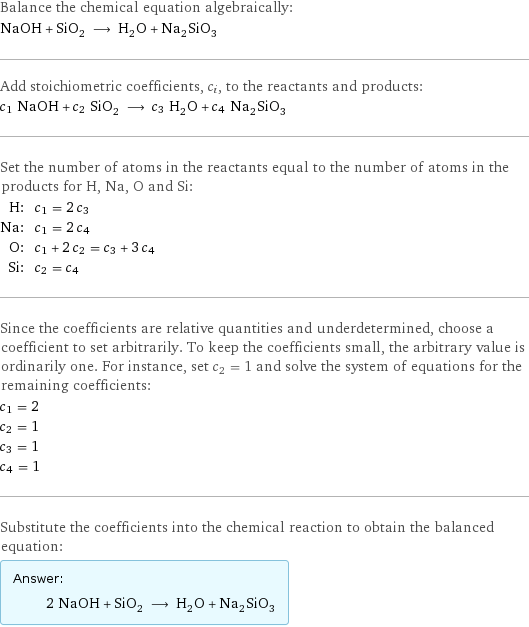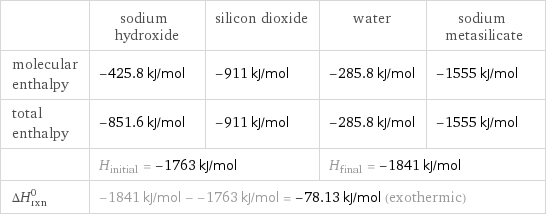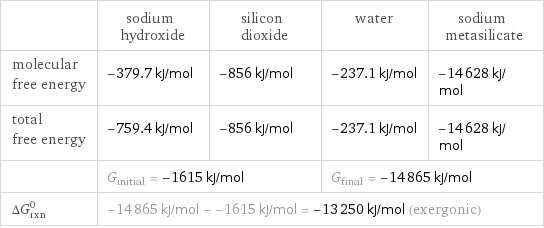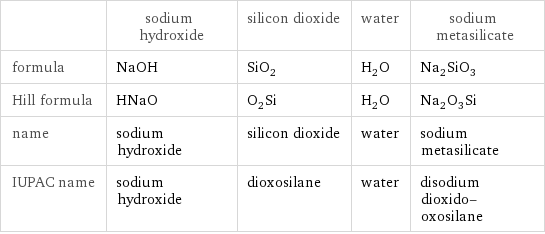Input interpretation

NaOH (sodium hydroxide) + SiO_2 (silicon dioxide) ⟶ H_2O (water) + Na_2SiO_3 (sodium metasilicate)
Balanced equation

Balance the chemical equation algebraically: NaOH + SiO_2 ⟶ H_2O + Na_2SiO_3 Add stoichiometric coefficients, c_i, to the reactants and products: c_1 NaOH + c_2 SiO_2 ⟶ c_3 H_2O + c_4 Na_2SiO_3 Set the number of atoms in the reactants equal to the number of atoms in the products for H, Na, O and Si: H: | c_1 = 2 c_3 Na: | c_1 = 2 c_4 O: | c_1 + 2 c_2 = c_3 + 3 c_4 Si: | c_2 = c_4 Since the coefficients are relative quantities and underdetermined, choose a coefficient to set arbitrarily. To keep the coefficients small, the arbitrary value is ordinarily one. For instance, set c_2 = 1 and solve the system of equations for the remaining coefficients: c_1 = 2 c_2 = 1 c_3 = 1 c_4 = 1 Substitute the coefficients into the chemical reaction to obtain the balanced equation: Answer: | | 2 NaOH + SiO_2 ⟶ H_2O + Na_2SiO_3
Structures

+ ⟶ +
Names

sodium hydroxide + silicon dioxide ⟶ water + sodium metasilicate
Reaction thermodynamics
Enthalpy

| sodium hydroxide | silicon dioxide | water | sodium metasilicate molecular enthalpy | -425.8 kJ/mol | -911 kJ/mol | -285.8 kJ/mol | -1555 kJ/mol total enthalpy | -851.6 kJ/mol | -911 kJ/mol | -285.8 kJ/mol | -1555 kJ/mol | H_initial = -1763 kJ/mol | | H_final = -1841 kJ/mol | ΔH_rxn^0 | -1841 kJ/mol - -1763 kJ/mol = -78.13 kJ/mol (exothermic) | | |
Gibbs free energy

| sodium hydroxide | silicon dioxide | water | sodium metasilicate molecular free energy | -379.7 kJ/mol | -856 kJ/mol | -237.1 kJ/mol | -14628 kJ/mol total free energy | -759.4 kJ/mol | -856 kJ/mol | -237.1 kJ/mol | -14628 kJ/mol | G_initial = -1615 kJ/mol | | G_final = -14865 kJ/mol | ΔG_rxn^0 | -14865 kJ/mol - -1615 kJ/mol = -13250 kJ/mol (exergonic) | | |
Equilibrium constant
![Construct the equilibrium constant, K, expression for: NaOH + SiO_2 ⟶ H_2O + Na_2SiO_3 Plan: • Balance the chemical equation. • Determine the stoichiometric numbers. • Assemble the activity expression for each chemical species. • Use the activity expressions to build the equilibrium constant expression. Write the balanced chemical equation: 2 NaOH + SiO_2 ⟶ H_2O + Na_2SiO_3 Assign stoichiometric numbers, ν_i, using the stoichiometric coefficients, c_i, from the balanced chemical equation in the following manner: ν_i = -c_i for reactants and ν_i = c_i for products: chemical species | c_i | ν_i NaOH | 2 | -2 SiO_2 | 1 | -1 H_2O | 1 | 1 Na_2SiO_3 | 1 | 1 Assemble the activity expressions accounting for the state of matter and ν_i: chemical species | c_i | ν_i | activity expression NaOH | 2 | -2 | ([NaOH])^(-2) SiO_2 | 1 | -1 | ([SiO2])^(-1) H_2O | 1 | 1 | [H2O] Na_2SiO_3 | 1 | 1 | [Na2SiO3] The equilibrium constant symbol in the concentration basis is: K_c Mulitply the activity expressions to arrive at the K_c expression: Answer: | | K_c = ([NaOH])^(-2) ([SiO2])^(-1) [H2O] [Na2SiO3] = ([H2O] [Na2SiO3])/(([NaOH])^2 [SiO2])](../image_source/d007f3ff8ff88e69a34d1a66a76caa66.png)
Construct the equilibrium constant, K, expression for: NaOH + SiO_2 ⟶ H_2O + Na_2SiO_3 Plan: • Balance the chemical equation. • Determine the stoichiometric numbers. • Assemble the activity expression for each chemical species. • Use the activity expressions to build the equilibrium constant expression. Write the balanced chemical equation: 2 NaOH + SiO_2 ⟶ H_2O + Na_2SiO_3 Assign stoichiometric numbers, ν_i, using the stoichiometric coefficients, c_i, from the balanced chemical equation in the following manner: ν_i = -c_i for reactants and ν_i = c_i for products: chemical species | c_i | ν_i NaOH | 2 | -2 SiO_2 | 1 | -1 H_2O | 1 | 1 Na_2SiO_3 | 1 | 1 Assemble the activity expressions accounting for the state of matter and ν_i: chemical species | c_i | ν_i | activity expression NaOH | 2 | -2 | ([NaOH])^(-2) SiO_2 | 1 | -1 | ([SiO2])^(-1) H_2O | 1 | 1 | [H2O] Na_2SiO_3 | 1 | 1 | [Na2SiO3] The equilibrium constant symbol in the concentration basis is: K_c Mulitply the activity expressions to arrive at the K_c expression: Answer: | | K_c = ([NaOH])^(-2) ([SiO2])^(-1) [H2O] [Na2SiO3] = ([H2O] [Na2SiO3])/(([NaOH])^2 [SiO2])
Rate of reaction
![Construct the rate of reaction expression for: NaOH + SiO_2 ⟶ H_2O + Na_2SiO_3 Plan: • Balance the chemical equation. • Determine the stoichiometric numbers. • Assemble the rate term for each chemical species. • Write the rate of reaction expression. Write the balanced chemical equation: 2 NaOH + SiO_2 ⟶ H_2O + Na_2SiO_3 Assign stoichiometric numbers, ν_i, using the stoichiometric coefficients, c_i, from the balanced chemical equation in the following manner: ν_i = -c_i for reactants and ν_i = c_i for products: chemical species | c_i | ν_i NaOH | 2 | -2 SiO_2 | 1 | -1 H_2O | 1 | 1 Na_2SiO_3 | 1 | 1 The rate term for each chemical species, B_i, is 1/ν_i(Δ[B_i])/(Δt) where [B_i] is the amount concentration and t is time: chemical species | c_i | ν_i | rate term NaOH | 2 | -2 | -1/2 (Δ[NaOH])/(Δt) SiO_2 | 1 | -1 | -(Δ[SiO2])/(Δt) H_2O | 1 | 1 | (Δ[H2O])/(Δt) Na_2SiO_3 | 1 | 1 | (Δ[Na2SiO3])/(Δt) (for infinitesimal rate of change, replace Δ with d) Set the rate terms equal to each other to arrive at the rate expression: Answer: | | rate = -1/2 (Δ[NaOH])/(Δt) = -(Δ[SiO2])/(Δt) = (Δ[H2O])/(Δt) = (Δ[Na2SiO3])/(Δt) (assuming constant volume and no accumulation of intermediates or side products)](../image_source/2554de8ce3a6f480df496bda3fa3a8d0.png)
Construct the rate of reaction expression for: NaOH + SiO_2 ⟶ H_2O + Na_2SiO_3 Plan: • Balance the chemical equation. • Determine the stoichiometric numbers. • Assemble the rate term for each chemical species. • Write the rate of reaction expression. Write the balanced chemical equation: 2 NaOH + SiO_2 ⟶ H_2O + Na_2SiO_3 Assign stoichiometric numbers, ν_i, using the stoichiometric coefficients, c_i, from the balanced chemical equation in the following manner: ν_i = -c_i for reactants and ν_i = c_i for products: chemical species | c_i | ν_i NaOH | 2 | -2 SiO_2 | 1 | -1 H_2O | 1 | 1 Na_2SiO_3 | 1 | 1 The rate term for each chemical species, B_i, is 1/ν_i(Δ[B_i])/(Δt) where [B_i] is the amount concentration and t is time: chemical species | c_i | ν_i | rate term NaOH | 2 | -2 | -1/2 (Δ[NaOH])/(Δt) SiO_2 | 1 | -1 | -(Δ[SiO2])/(Δt) H_2O | 1 | 1 | (Δ[H2O])/(Δt) Na_2SiO_3 | 1 | 1 | (Δ[Na2SiO3])/(Δt) (for infinitesimal rate of change, replace Δ with d) Set the rate terms equal to each other to arrive at the rate expression: Answer: | | rate = -1/2 (Δ[NaOH])/(Δt) = -(Δ[SiO2])/(Δt) = (Δ[H2O])/(Δt) = (Δ[Na2SiO3])/(Δt) (assuming constant volume and no accumulation of intermediates or side products)
Chemical names and formulas

| sodium hydroxide | silicon dioxide | water | sodium metasilicate formula | NaOH | SiO_2 | H_2O | Na_2SiO_3 Hill formula | HNaO | O_2Si | H_2O | Na_2O_3Si name | sodium hydroxide | silicon dioxide | water | sodium metasilicate IUPAC name | sodium hydroxide | dioxosilane | water | disodium dioxido-oxosilane